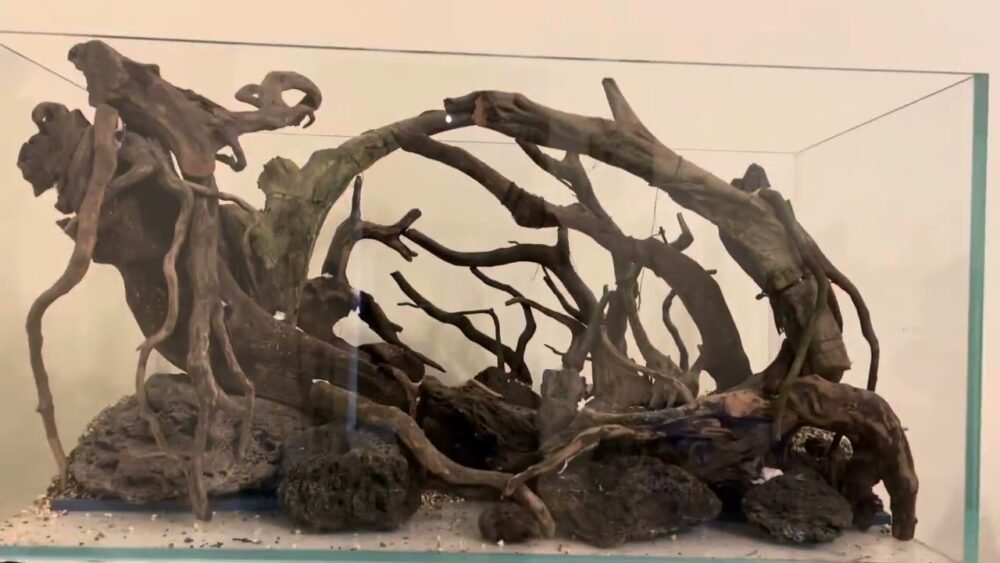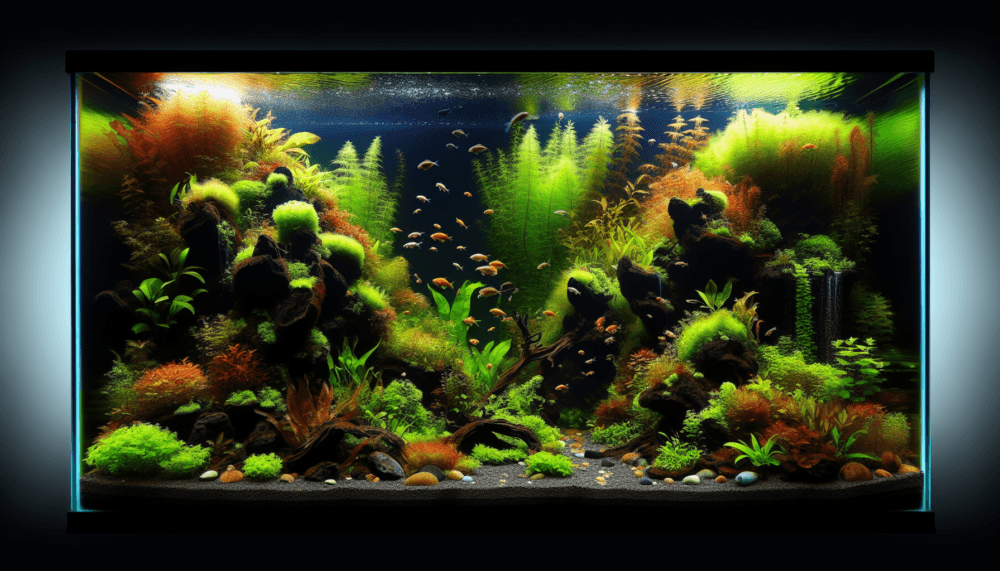Today, we are going to explore the mesmerizing process of creating a stunning 90cm Aquascape, from start to finish. This captivating video, created by the talented Richard Enriquez, takes you on a visual journey that will leave you in awe. With the perfect combination of music and visuals, this video encapsulates the artistry and dedication that goes into crafting a breathtaking aquatic masterpiece. From the moment you press play, you will be transported into a world of lush greenery, tranquil waters, and an array of vibrant aquatic flora and fauna. Richard’s meticulous attention to detail and passion for Aquascaping shines through in every frame, making this video an absolute delight to watch.
As you watch this video, you will be guided through each step of the process, from the initial layout and hardscape design, to the careful selection and placement of aquatic plants. Richard’s expertise is evident as he skillfully arranges and manicures the underwater landscape, ensuring that every element finds its perfect place. You will witness the effortless flow of water, the delicate sway of aquatic plants, and the vibrant colors that bring the entire Aquascape to life. Whether you are an experienced Aquascaper or simply have an appreciation for the beauty of nature, this video is sure to leave you inspired and eager to embark on your own Aquascaping journey. So sit back, relax, and prepare to be enchanted by the mesmerizing art of creating a stunning 90cm Aquascape.
Choosing the Right Tank
When it comes to setting up your own aquascape, one of the first things you need to consider is choosing the right tank. The size and shape of the tank are important factors to consider. A larger tank will provide more space for your fish and plants to thrive, while a smaller tank may be more suitable for a beginner or for those who have limited space. The shape of the tank can also affect the overall aesthetics of your aquascape. Do you prefer a traditional rectangular tank, or would you like to experiment with a more unique shape like a cube or a bow-front tank?
Another consideration when choosing a tank is the material it is made of. The most common materials for aquarium tanks are glass and acrylic. Glass tanks are more durable and scratch-resistant, but they can be heavier and more expensive. Acrylic tanks, on the other hand, are lighter and have better clarity, but they can be prone to scratching. It’s important to weigh the pros and cons of each material and choose the one that suits your needs and budget.
Lastly, researching on different tank brands is essential. Look for reputable brands that have a good track record of producing high-quality tanks. Read reviews from other aquascapers and consider their feedback before making your final decision. Ultimately, choosing the right tank is the foundation for a successful aquascape.
Planning the Layout
Once you have chosen the right tank, it’s time to start planning the layout of your aquascape. The design style you choose will set the overall theme and atmosphere of your tank. Do you prefer a natural-looking aquascape with lush green plants and driftwood, or do you lean more towards a minimalist and modern design with clean lines and a few carefully selected hardscape elements? It’s important to consider your personal preferences and the overall aesthetic you want to achieve.
When planning the layout, it’s also important to consider the needs of your plants and fish. Some plants require more light and nutrients, while others prefer a shaded area. Consider the lighting requirements of your chosen plants and plan accordingly. Additionally, think about the needs of your fish in terms of swimming space and hiding spots. Creating a hardscape plan that incorporates these factors will ensure that your aquascape is not only visually appealing but also provides a suitable environment for your aquatic inhabitants.

This image is property of i.ytimg.com.
Selecting the Substrate
The substrate plays a crucial role in your aquascape. It not only provides a foundation for your plants to root in but also plays a role in maintaining water chemistry. Understanding the role of substrate is important before making a choice.
When choosing the right type and depth of substrate, consider the needs of your plants. Some plants, like carpeting plants, require a fine-grained substrate that allows their roots to spread easily, while others may do well with a coarser substrate. Determining the depth of the substrate is also important, as it can affect the growth and stability of your plants.
Preparing the substrate before adding it to the tank is crucial. Rinse the substrate thoroughly to remove any dust or debris that may cloud the water. This will ensure a clean and clear environment for your aquatic plants and fish.
Installing the Filtration System
Proper filtration is essential for maintaining a healthy and balanced ecosystem in your aquascape. Understanding the importance of filtration will help you make the right choices for your tank.
There are various types of filters available, including internal filters, external canister filters, and sponge filters. Each type of filter has its own advantages and disadvantages, so it’s important to select the one that best suits your needs. Consider the size of your tank, the type and number of fish you plan to keep, and the amount of maintenance you are willing to put in when selecting the appropriate filter.
Once you have selected the filter, setting it up correctly is crucial. Follow the manufacturer’s instructions to ensure proper installation and maintenance. It’s also important to clean and maintain the filter regularly to keep it functioning at its best.

Choosing the Lighting
Lighting is an important aspect of any aquascape. It not only provides illumination for your tank but also plays a vital role in the photosynthesis process of your aquatic plants. Understanding the importance of lighting will help you make informed decisions for your aquascape.
Selecting the correct intensity and spectrum of light is crucial for the health and growth of your plants. Different plants have different lighting requirements, so it’s important to research the needs of your chosen plants. Consider the color temperature and intensity of the light source, as well as the duration of lighting.
Installing the lighting system requires careful consideration. Determine the appropriate placement of the lights to ensure even distribution of light throughout the tank. Consider using a timer to regulate the photoperiod, simulating the natural day and night cycle for your aquatic plants and fish.
Adding Hardscape Elements
Hardscape elements, such as rocks and wood, can add depth, texture, and visual interest to your aquascape. Selecting the right rocks and wood is crucial for achieving the desired effect.
When choosing rocks, consider their composition and appearance. Avoid rocks that may alter the water chemistry or release harmful substances into the water. Select rocks that have a natural, weathered appearance, as they will blend seamlessly with your aquascape.
Wood is another popular hardscape element that can add a natural and organic feel to your tank. When selecting wood, consider its size, shape, and texture. Ensure that the wood is safe for aquarium use and will not leach harmful substances into the water.
Creating a layout with hardscape requires careful planning and consideration. Experiment with different arrangements to find the one that best suits your vision. Once you are satisfied with the layout, position and secure the hardscape pieces in your tank using aquarium-safe adhesive or silicone.

Introducing Aquatic Plants
Aquatic plants are not only aesthetically pleasing but also play a vital role in the overall health and balance of your aquascape. Researching different plant species will help you make informed decisions when selecting and arranging your plants.
Consider the growth requirements of the plants, including lighting, temperature, and nutrient requirements. Some plants may require additional CO2 supplementation, while others may thrive with minimal assistance. Arrange the plants in a way that creates a visually appealing and balanced aquascape. Place taller plants towards the back of the tank and shorter plants towards the front to create depth and perspective.
Provide adequate nutrients and CO2 for your plants to thrive. Use a quality aquatic plant fertilizer and consider adding a CO2 system if necessary. Regularly trim and maintain your plants to promote healthy growth and prevent overcrowding.
Introducing Fish and Invertebrates
The selection of fish and invertebrates for your aquascape is an exciting part of the process. Researching compatible species will help you create a harmonious and balanced aquatic ecosystem.
Consider the size, temperament, and dietary needs of the fish and invertebrates you plan to introduce. Avoid combining species that may exhibit aggressive behaviors or have conflicting dietary requirements. Create a list of compatible species and plan the stocking order accordingly.
Introduce the fish and invertebrates slowly to allow them to acclimate to their new environment. Monitor their behavior and health closely to ensure they are thriving in their new home. Make any necessary adjustments to the tank environment, such as water parameters or feeding habits, to meet the needs of your aquatic animals.
Maintaining Water Parameters
Maintaining optimal water parameters is essential for the health and well-being of your aquascape. Regular monitoring and adjustments are necessary to create a stable and balanced environment for your plants and fish.
Monitor and adjust the temperature of the tank to suit the needs of your livestock. Use a reliable aquarium thermometer to ensure accurate readings. Maintain optimal pH levels by testing the water regularly and using appropriate pH adjusters if needed.
Regular water testing is crucial to monitor the levels of ammonia, nitrites, and nitrates in the tank. Perform regular water changes to maintain low levels of these chemicals and ensure a healthy environment for your aquatic life.
Conclusion
Creating and maintaining an aquascape requires careful planning and consideration. Choosing the right tank, planning the layout, selecting the substrate, installing the filtration system, choosing the lighting, adding hardscape elements, introducing aquatic plants and fish, and maintaining water parameters are all integral steps in the process.
Remember to thoroughly research and understand each step before proceeding, and don’t be afraid to seek advice from experienced aquascapers or professionals if needed. With patience, knowledge, and a bit of creativity, you can create a stunning and thriving aquascape that brings joy and tranquility to your space. Enjoy the journey and happy aquascaping!